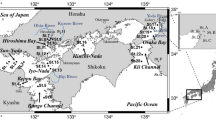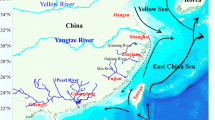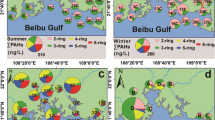Abstract
The Red Sea is a unique aquatic environment, and it is host to highly biodiverse marine organisms. This body of water occurs along the western side of Saudi Arabia, which is one of the largest producers of crude oil in the world. Thus, the sea’s contamination by oil pollutants could pose a large problem and is a major concern in the region. The samples were analyzed to determine their polycyclic aromatic hydrocarbon (PAH) speciation and assess the associated ecological risk to the coastal environment of the Red Sea. The geographical distribution of the 16 total PAHs by concentration (range and average values in ng g−1 dry wt.) occurred in the following order: the northern region (1169.8 to 2742.0; 2083) < the southern region (1971.4 to 3003.4; 2493) < the middle region (2222.0 to 2930.6; 2599). The PAHs with two, three, four, five, and six rings make up 7.0%, 13.0%, 70.0%, and 10.0% of the total PAHs, respectively. The diagnostic ratio results showed that the PAHs may be attributed to petrogenic and pyrogenic sources. The PAH concentrations were considered toxic when their levels ranged from 119 to 491 ng toxic equivalent g−1 dry wt. According to the mean range of PAH effects (the mean effect range median quotient values), the ecological risk posted by the investigated sediments was lower than 0.1, denoting a toxicity effect with a probability of 11%. The analysis of PAHs highlighted that the sampling sites were low priority sites, and their PAHs may not cause acute biological damage.



Similar content being viewed by others
References
Abdallah, R. I., Khalil, N. M., & Roushdy, M. I. (2016). Monitoring of pollution in sediments of the coasts in Egyptian Red Sea. Egyptian Journal of Petroleum, 25(1), 133–151.
Agarwal, T., & Bucheli, T. D. (2011). Is black carbon a better predictor of polycyclicaromatic hydrocarbon distribution in soils than total organic carbon? Environmental Pollution, 159, 64–70.
Al-Farawati, R. (2010). Environmental conditions of the coastal waters of southern Corinche, Jeddah, eastern Red Sea: physico-chemical approach. Australian Journal of Basic and Applied Sciences, 4, 3324.
Ali, A., Elazein, E., & Alian, M. (2011). Investigation of heavy metals pollution in water, sediment and fish at Red Sea-Jeddah coast-KSA at two different locations. Journal of Applied Environmental Biological Sciences, 1, 630.
Al-Mur, B. A., Quicksall, A. N., & Al-Ansari, A. M. A. (2017). Spatial and temporal distribution of heavy metals in coastal core sediments from the Red Sea, Saudi Arabia. Oceanologia, 59(3), 262–270.
Alves, C., Pio, C., & Duarte, A. (2001). Composition of extractable organic matter of air particles from rural and urban Portuguese areas. Atmospheric Environment, 35(32), 5485–5496.
Al-Washmi, H. A. (1999). Sedimentological aspects and environmental conditions recognized from the bottom sediments of Al-Kharrar lagoon, eastern Red Sea coastal plain, Saudi Arabia. Journal of King Abdulaziz University, 10, 71–87.
Anyakora, C. H., Coker, H., & Arbabi, M. (2011). Application of polynuclear aromatic hydrocarbons in chemical fingerprinting: the Niger Delta case study. Iranian Journal of Environmental Health Science & Engineering, 8(1), 75–84.
Barakat, A. O., Mostafa, A., Wade, T. L., Sweet, S. T., & El Sayed, N. B. (2011). Distribution and characteristics of PAHs in sediments from the Mediterranean coastal environment of Egypt. Marine Pollution Bulletin, 62(9), 1969–1978.
Basaham, A. S. (2008). Mineralogical and chemical composition of the mud fraction from the surface sediments of Sharm Al-Kharrar, a Red Sea coastal lagoon. Oceanologia, 50(4), 557–575.
Battalwar, D. G., Yenkie, M. K. N., Meshram, S. U., & Puri, P. J. (2012). Studies on presence of PAHs in ambient air of Nagpur City (India). Rasayan Journal of Chemistry, 5(3), 345–350.
Brandli, R. C., Bucheli, T. D., Kupper, T., Mayer, J., Stadelmann, F. X., & Tarradellas, J. (2007). Fate of PCBs, PAHs and their source characteristic ratios during composting and digestion of source-separated organic waste in full-scale plants. Environmental Pollution, 148, 520–528.
Budzinski, H., Jones, I., Bellocq, J., Pierrad, C., & Garrigues, P. (1997). Evaluation of sediment contamination by polycyclic aromatic hydrocarbons in the Gironde estuary. Marine Chemistry, 58, 85–97.
Chen, C.-W., & Chen, C.-F. (2011). Distribution, origin, and potential toxicological significance of polycyclic aromatic hydrocarbons (PAHs) in sediments of Kaohsiung Harbor, Taiwan. Marine Pollution Bulletin, 63(5–12), 417–423.
Countway, R. E., Dickhut, R. M., & Canuel, E. (2003). Polycyclic aromatic hydrocarbon (PAH) distributions and associations with organic matter in surface waters of the York River, VA estuary. Organic Geochemistry, 34, 209–224.
da Silva, T. F., Azevedo, D. D. A., & Neto, F. R. D. A. (2007). Distribution of polycyclic aromatic hydrocarbons in surface sediments and waters from Guanabara Bay, Rio de Janeiro, Brazil. Journal of the Brazilian Chemical Society, 18(3), 628–637.
de Luca, G., Furesi, A., Leardi, R., Micera, G., Panzanelli, A., Piu, P. C., & Sanna, G. (2004). Polycyclic aromatic hydrocarbons assessment in the sediments of the Porto Torres Harbor (northern Sardinia, Italy). Marine Chemistry, 86(1–2), 15–32.
Edokpayi, J., Odiyo, J., Popoola, O., & Msagati, T. (2016). Determination and distribution of polycyclic aromatic hydrocarbons in rivers, sediments and wastewater effluents in Vhembe District, South Africa. International Journal of Environmental Research and Public Health, 13(4), 387.
El Nemr, A., El-Sadaawy, M. M., Khaled, A., & El-Sikaily, A. (2014). Distribution patterns and risks posed of polycyclic aromatic hydrocarbons contaminated in the surface sediment of the Red Sea coast (Egypt). Desalination and Water Treatment, 52(40–42), 7964–7982.
El Sayed, M. A., & Basaham, A. S. (2004). Speciation and mobility of some heavy metals in the coastal sediments of Jeddah, eastern Red Sea. Arab Gulf Journal of Scientific Research, 22, 226.
El-Maradny, A. A., Turki, A. J., Shaban, Y. A., & Sultan, K. M. (2015). Levels and distribution of polychlorinated biphenyls in Jeddah coastal sediments, Red Sea, Saudi Arabia. Journal of the Chemical Society of Pakistan, 37(3), 599.
Fairey, R., Long, E. R., Roberts, C. A., Anderson, B. S., Phillips, B. M., Hunt, J. W., Puckett, H. R., & Wilson, C. J. (2001). An evaluation of methods for calculating mean sediment quality guideline quotients as indicators of contamination and acute toxicity to amphipods by chemical mixtures. Environmental Toxicology and Chemistry, 20, 2276–2286.
Feng, J., Xi, N., Zhang, F., Zhao, J., Hu, P., & Sun, J. (2015). Distributions and potential sources of polycyclic aromatic hydrocarbons in surface sediments from an emerging industrial city (Xinxiang). Environmental Monitoring and Assessment, 188(1), 1–14.
Fisler, R. (1987). Polycyclic aromatic hydrocarbon hazards to fish, wildlife and invertebrate: a synoptic review. Laurel: U. S. Fish and Wildlife Service Patuxent Wildlife Research Center.
Folk, R. L. (1974). Petrology of sedimentary rocks. Austin: Hemphill.
Fowler, S. W., Readman, J. W., Oregioni, B., Villeneuve, J. P., & McKay, K. (1993). Petroleum hydrocarbons and trace metals in nearshore gulf sediments and biota before and after the 1991 war: an assessment of temporal and spatial trends. Marine Pollution Bulletin, 27, 171–182.
Gaudette, H., Flight, W., Toner, L., & Folger, D. (1974). An inexpensive titration method for the determination of organic carbon in recent sediments. Journal of Sedimentary Research, 44(1), 249–253.
Ghandour, I. M., Basaham, A. S., Al-Washmi, H. A., & Masuda, H. (2014). Natural and anthropogenic controls on sediment composition of an arid coastal environment: Sharm Obhur, Red Sea, Saudi Arabia. Environmental Monitoring and Assessment, 186(3), 1465–1484.
Gorleku, M. A., Carboo, D., Palm, L. M. N., Quasie, W. J., & Armah, A. K. (2014). Polycyclic aromatic hydrocarbons (PAHs) pollution in marine waters and sediments at the Tema Harbour, Ghana. Academia Journal of Environmental Sciences, 2(7), 108–115.
Gu, Y.-G., Ke, C.-L., Liu, Q., & Lin, Q. (2016). Polycyclic aromatic hydrocarbons (PAHs) in sediments of Zhelin Bay, the largest mariculture base on the eastern Guangdong coast, South China: characterization and risk implications. Marine Pollution Bulletin, 110(1), 603–608.
Jiang, J.-J., Lee, C.-L., Fang, M.-D., & Liu, J. T. (2009). Polycyclic aromatic hydrocarbons in coastal sediments of southwest Taiwan: an appraisal of diagnostic ratios in source recognition. Marine Pollution Bulletin, 58(5), 752–760.
Kamal, A., Malik, R. N., Martellini, T., & Cincinelli, A. (2014). PAH exposure biomarkers are associated with clinico-chemical changes in the brick kiln workers in Pakistan. Science of the Total Environment, 490, 521–527.
Katsoyiannis, A., & Breivik, K. (2014). Model-based evaluation of the use of polycyclic aromatic hydrocarbons molecular diagnostic ratios as a source identification tool. Environmental Pollution, 184, 488–494.
Ke, L., Wong, T. W. Y., Wong, Y. S., & Tam, N. F. Y. (2002). Fate of polycyclic aromatic hydrocarbon (PAH) contamination in a mangrove swamp in Hong Kong following an oil spill. Marine Pollution Bulletin, 45(1–12), 339–347.
Keshavarzifard, M., Zakaria, M. P., Hwai, T. S., Yusuff, F. F. M., Mustafa, S., Vaezzadeh, V., Magam, S. M., Masood, N., Alkhadher, S. A. A., & Abootalebi-Jahromi, F. (2014). Baseline distributions and sources of polycyclic aromatic hydrocarbons (PAHs) in the surface sediments from the Prai and Malacca Rivers, Peninsular Malaysia. Marine Pollution Bulletin, 88(1–2), 366–372.
Kuo, J.-Y., Ko, F.-C., Cheng, J.-O., Meng, P.-J., Li, J.-J., & Hung, C.-C. (2012). Environmental assessment of polycyclic aromatic hydrocarbons in the surface sediments of a remote region on the eastern coast, Taiwan. Environmental Monitoring and Assessment, 184(5), 2967–2979.
Li, Z., Chen, L., Liu, S., Ma, H., Wang, L., An, C., & Zhang, R. (2016). Characterization of PAHs and PCBs in fly ashes of eighteen coal-fired power plants. Aerosol and Air Quality Research, 16(12), 3175–3186.
Liu, G., Niu, Z., van Niekerk, D., Xue, J., & Zheng, L. (2008). Polycyclic aromatic hydrocarbons (PAHs) from coal combustion: emissions, analysis, and toxicology. In D. M. Whitacre (Ed.), Reviews of environmental contamination and toxicology (pp. 1–28). New York: Springer.
Liu, A., Lang, Y., Xue, L., & Liu, J. (2009). Ecological risk analysis of polycyclic aromatic hydrocarbons (PAHs) in surface sediments from Laizhou Bay. Environmental Monitoring and Assessment, 159(1–4), 429–436.
Lohmann, R., Macfarlane, J. K., & Gschwend, P. M. (2005). Importance of black carbon tosorption of native PAHs, PCBs, and PCDDs in Boston and New York harbor sediments. Environmental Science & Technology, 39, 141–148.
Long, E. R., Macdonald, D. D., Smith, S. L., & Calder, F. D. (1995). Incidence of adverse biological effects within ranges of chemical concentrations in marine and estuarine sediments. Environmental Management, 19(1), 81–97.
Malik, A., Verma, P., Singh, A. K., & Singh, K. P. (2011). Distribution of polycyclic aromatic hydrocarbons in water and bed sediments of the Gomti River, India. Environmental Monitoring and Assessment, 172(1), 529–545.
Martins, C. C., Bícego, M. C., Rose, N. L., Taniguchi, S., Lourenço, R. A., Figueira, R. C. L., Mahiques, M. M., & Montone, R. C. (2010). Historical record of polycyclic aromatic hydrocarbons (PAHs) and spheroidal carbonaceous particles (SCPs) in marine sediment cores from Admiralty Bay, King George Island, Antarctica. Environmental Pollution, 158(1), 192–200.
Molina, B. F. (1974). A rapid and accurate method for the analysis of calcium carbonate in small samples. Journal of Sedimentary Petrology, 44(2), 589–590.
Mostafa, A. R., Wade, T. L., Sweet, S. T., Al-Alimi, A. K. A., & Barakat, A. O. (2009). Distribution and characteristics of polycyclic aromatic hydrocarbons (PAHs) in sediments of Hadhramout coastal area, Gulf of Aden, Yemen. Journal of Marine Systems, 78(1), 1–8.
Nadal, M., Schuhmacher, M., & Domingo, J. L. (2004). Levels of PAHs in soil and vegetation samples from Tarragona County, Spain. Environmental Pollution, 132(1), 1–11.
Nascimento, R. A., de Almeida, M., Escobar, N. C. F., Ferreira, S. L. C., Mortatti, J., & Queiroz, A. F. S. (2017). Sources and distribution of polycyclic aromatic hydrocarbons (PAHs) and organic matter in surface sediments of an estuary under petroleum activity influence, Todos os Santos Bay, Brazil. Marine Pollution Bulletin, 119(2), 223–230.
Nasher, E., Heng, L. Y., Zakaria, Z., & Surif, S. (2013). Assessing the ecological risk of polycyclic aromatic hydrocarbons in sediments at Langkawi Island, Malaysia. The Scientific World Journal, 2013, 1–13.
Obayori, O. S., & Salam, L. B. (2010). Degradation of polycyclic aromatic hydrocarbons: role of plasmids. Scientific Research and Essays, 5(25), 4093–4106.
Pekey, H., Karakaş, D., Ayberk, S., Tolun, L., & Bakoǧlu, M. (2004). Ecological risk assessment using trace elements from surface sediments of İzmit Bay (northeastern Marmara Sea) Turkey. Marine Pollution Bulletin, 48(9–10), 946–953.
Qiao, M., Wang, C., Huang, S., Wang, D., & Wang, Z. (2006). Composition, sources, and potential toxicological significance of PAHs in the surface sediments of the Meiliang Bay, Taihu Lake, China. Environment International, 32, 28–33.
Rasiq, K. T., El-Maradny, A., Bashir, M. E., & Orif, M. (2018). Polycyclic aromatic hydrocarbons (PAHs) in surface sediments of two polluted lagoons in Saudi Arabia. Polish Journal of Environmental Studies, 27(1), 275–285.
Rifaat, A. R. (1996). Metal composition of recent carbonate sediments off Jeddah, Kingdom of Saudi Arabia. Marine Scienes-Ceased lssuerg, 17(1), 1–2.
Roozbeh, M., Iraj, F., & Ehsan, A. (2012). Contamination of polycyclic aromatic hydrocarbons in surface sediments of Khure-Musa estuarine, Persian Gulf. Journal of Fish and Marine Sciences, 4(2), 136–141.
Salem, D. M. S. A., Morsy, F. A.-E. M., El Nemr, A., El-Sikaily, A., & Khaled, A. (2014). The monitoring and risk assessment of aliphatic and aromatic hydrocarbons in sediments of the Red Sea, Egypt. The Egyptian Journal of Aquatic Research, 40(4), 333–348.
Savinov, V. M., Savinova, T. N., Matishov, G. G., Dahle, S., & Næs, K. (2003). Polycyclic aromatic hydrocarbons (PAHs) and organochlorines (OCs) in bottom sediments of the Guba Pechenga, Barents Sea, Russia. Science of the Total Environment, 306(1–3), 39–56.
Shabbaj, I. I., Alghamdi, M. A., & Khoder, M. I. (2018). Street dust—bound polycyclic aromatic hydrocarbons in a Saudi coastal city: status, profile, sources, and human health risk assessment. International Journal of Environmental Research and Public Health, 15(11), 2397. https://doi.org/10.3390/ijerph15112397.
Sienra, M. D. R., Rosazza, N. G., & Préndez, M. (2005). Polycyclic aromatic hydrocarbons and their molecular diagnostic ratios in urban atmospheric respirable particulate matter. Atmospheric Research, 75(4), 267–281.
Szabová, E., Zeljenková, D., Nesčáková, E., Šimko, M., & Turecký, L. (2008). Polycyclic aromatic hydrocarbons and occupational risk factor. Reproductive Toxicology, 26(1), 74.
Timoney, K. P., & Lee, P. (2011). Polycyclic aromatic hydrocarbons increase in Athabasca River Delta sediment: temporal trends and environmental correlates. Environmental Science & Technology, 45, 4278–4284.
Tobiszewski, M., & Namieśnik, J. (2012). PAH diagnostic ratios for the identification of pollution emission sources. Environmental Pollution, 162, 110–119.
Turki, A. J. (2006). Concentration of some heavy metals in surface sediments of a coastal Red Sea lagoon receiving domestic sewage, Journal of Egyptian Academic Society for Environmental Development, (D – Environmental Studies). 7 (3): 21–40.
USEPA. (1993). Provisional guidance for quantitative risk assessment of polycyclic aromatic hydrocarbons, EPA/600/R-93/089. Washington, DC: Office of Research and Development, US Environment Protection Agency.
Wade, T. L., & Cantillo, A. Y. (1994). Use of standards and reference materials in the measurement of chlorinated hydrocarbon residues. Chemistry workbook. NOAA Technical Memorandum NOS ORCA 77. Silver Spring: US Department of Commerce.
Wade, T. L., Atlas, E. L., Brooks, J. M., Kennicutt, M. C., Fox, R. G., Sericano, J., Garcia-Romero, B., & DeFreitas, D. (1988). NOAA Gulf of Mexico status and trends program: trace organic contaminant distribution in sediments and oysters. Estuaries, 11(3), 171–179.
Wang, L., Yang, Z., Niu, J., & Wang, J. (2009). Characterization, ecological risk assessment and source diagnostics of polycyclic aromatic hydrocarbons in water column of the Yellow River Delta, one of the most plenty biodiversity zones in the world. Journal of Hazardous Materials, 169(1–3), 460–465.
Wang, C., Du, J., Gao, X., Duan, Y., & Sheng, Y. (2011). Chemical characterization of naturally weathered oil residues in the sediment from Yellow River Delta, China. Marine Pollution Bulletin, 62(11), 2469–2475.
Wang, C., Dao, X., Zhang, L. L., Lv, Y. B., & Teng, E. J. (2015). Characteristics and toxicity assessment of airborne particulate polycyclic aromatic hydrocarbons of four background sites in China. Zhongguo Huanjing Kexue/China Environmental Science, 35, 3543–3549.
Xie, W., Chen, A., Li, J., Liu, Q., Yang, H., & Lu, Z. (2012). County-scale distribution of polycyclic aromatic hydrocarbons in topsoil of the Yellow River Delta region. Journal of Environmental Science and Health, Part A, 47(10), 1419–1427.
Xue, B., Wang, Y., Zhang, D., Zhang, J., Leng, B., Huang, W., & Chen, Z. (2013). Concentration, distribution and sources of polycyclic aromatic hydrocarbons (PAHs) in surface sediments from Lijiang River, South China. Bulletin of Environmental Contamination and Toxicology, 90(4), 446–450.
Yang, H., Hsieh, L., Liu, H., & Mi, H. (2005). Polycyclic aromatic hydrocarbon emissions from motorcycles. Atmospheric Environment, 39(1), 17–25.
Yang, T.-T., Hsu, C.-Y., Chen, Y.-C., Young, L.-H., Huang, C.-H., & Ku, C.-H. (2017). Characteristics, sources, and health risks of atmospheric PM2.5-bound polycyclic aromatic hydrocarbons in Hsinchu, Taiwan. Aerosol and Air Quality Research, 17(2), 563–573.
Yim, U. H., Ha, S. Y., An, J. G., Won, J. H., Han, G. M., Hong, S. H., Kim, M., Jung, J.-H., & Shim, W. J. (2011). Fingerprint and weathering characteristics of stranded oils after the Hebei Spirit oil spill. Journal of Hazardous Materials, 197, 60–69.
Yunker, M. B., Macdonald, R. W., Vingarzan, R., Mitchell, R. H., Goyette, D., & Sylvestre, S. (2002). PAHs in the Fraser River basin: a critical appraisal of PAH ratios as indicators of PAH source and composition. Organic Geochemistry, 33(4), 489–515.
Acknowledgments
The author gratefully acknowledges the Deanship of Scientific Research (DSR) for its technical and financial support.
Funding
This work was supported by the Deanship of Scientific Research (DSR), King Abdulaziz University, Jeddah, under grant no. D-067-155-1439.
Author information
Authors and Affiliations
Corresponding author
Additional information
Publisher’s note
Springer Nature remains neutral with regard to jurisdictional claims in published maps and institutional affiliations.
Rights and permissions
About this article
Cite this article
Al-Mur, B.A. Assessing the ecological risks from hydrocarbons in the marine coastal sediments of Jeddah, Red Sea. Environ Monit Assess 191, 180 (2019). https://doi.org/10.1007/s10661-019-7262-1
Received:
Accepted:
Published:
DOI: https://doi.org/10.1007/s10661-019-7262-1




